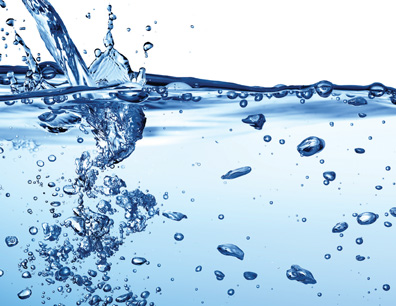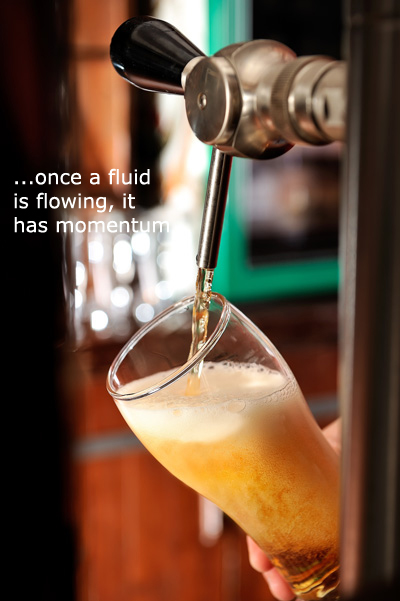- By Raymond Mulley, PE
- Automation Basics
Summary
By Raymond Mulley, PE

Some material in this section may seem self-evident to recent engineering graduates. However, it is worth establishing some basic concepts as a springboard to what follows. It does not hurt to review basic material from time to time. It is surprising what one forgets-or never learned.
Compressibility of all fluids
Many terms used in the field of hydraulics are simplified descriptions of reality. Sometimes these didactic simplifications are useful; sometimes they are not. They help younger people over early hurdles and hinder them in their later comprehension. The name of the term, itself, can lead to conceptual errors. For instance, the distinction between an incompressible fluid and a compressible one is just a matter of degree. There may be orders of magnitude between the compressibility of a gas and that of a liquid; nevertheless, it is wise to bear in mind that all fluids are compressible to some degree-even the ones we call "incompressible." Later, we will show how compressibility helps explain another logical inconsistency-fluid friction.
Mechanism of flow
It is obvious to anyone who has ever used a garden hose that water flows when there is a higher pressure upstream than downstream. When we open a tap, or faucet, the higher pressure in the pipe causes water to flow. This common observation leads to the assumption that a higher pressure upstream than downstream is always associated with flow. The assumption is not correct. It is true a higher pressure is required upstream to start a fluid flowing across a restriction. However, once a fluid is flowing, it has momentum. As will be developed in greater detail when we discuss the Bernoulli equation, pressure is associated with one form of energy, static energy, and energy can take on different forms. One of these forms is kinetic energy. When a high velocity fluid flows from a small diameter pipe through a swage to a larger diameter pipe, the fluid slows down because of the continuity principle. In slowing down, some of its kinetic energy is changed to static energy. This change can cause the pressure downstream to be greater than the pressure upstream of the swage. This phenomenon is called pressure recovery.
It is not necessary to have a higher pressure upstream in order to initiate flow. If a pipe is connected to an open reservoir-for instance, a water tower in a city water distribution network-flow will begin once a valve is opened. The pressure on the surface of the water in the reservoir is approximately equal to the pressure in a kitchen sink. In this case, there is no difference in pressure between the ends of the piping system, but flow occurs. There is more than just pressure difference involved in the flow of water. An unbalanced force in the direction of the flow is necessary.
Reestablishing equilibrium
The phenomenon of flow in conduits (pipes) is best thought of as an attempt to reestablish an equilibrium state in a fluid constrained by conduit walls. In a closed system under pressure, when all valves are shut, all forces are accompanied by equal and opposite forces. The fluid is stationary. In an open system, when valves are open, there is an imbalance of forces, and the fluid moves in a direction that will reestablish equilibrium. If mass and energy are added continuously to an open system, flow will be continuous.
The mass added could be water flowing to a reservoir behind a dam, or water pumped to a head tank. Once there, the water has energy by virtue of its position. This energy is potential energy or the potential to do work. Upstream of a closed tap, faucet, or valve, the water will be subject to the weight (force) of the water above it. It will exert a pressure (force per unit area) to equilibrate this force. This pressure is the result of repulsion arising when molecules approach one another. The pressure is associated with a static fluid and with a form of energy called static energy.
If the valve is opened, the water will flow through it by virtue of the pressure difference across it. The pressure upstream of the valve will decrease for two reasons. First, some of the pressure energy has been converted to kinetic energy, the energy a body has by virtue of its motion. Second, some of the energy of the water has been converted to internal energy because of what is commonly called "fluid friction" in the upstream piping. The increase in internal energy is accompanied by an increase in temperature-hence, the loose term, "thermal energy." This loose term shortly will be explained more fully.
The kinetic energy is recoverable. It can be transformed back to static (pressure) energy by closing the valve or to potential energy by connecting an open, vertical pipe to an elevation equal to that of the reservoir. The incremental internal energy is not completely recoverable to one of the mechanical forms of energy. This is the reason the water in the previously mentioned vertical pipe cannot quite reach the original elevation of the surface of the reservoir. The incremental internal energy flows as heat through the pipe walls and is lost to practical use. It warms up the atmosphere. In a well-insulated pipe, it remains with the fluid for a longer period of time and is seen as a higher fluid temperature.
Logical inconsistency of fluid friction
The term "fluid friction" is commonly used to explain losses in mechanical forms of energy associated with fluid flow. A little knowledge of physics shows it is a poorly chosen term. Friction is a macroscopic phenomenon-such as when two blocks of wood slide over one another, or when the rubber hits the road. There is a definite resisting force to be overcome-the force of friction.
Fluid molecules do not touch
Fluids are made up of molecules, and molecules do not touch in the fluid state. Collisions of gas molecules are actually repulsions that prevent the molecules from touching. Liquid molecules are less energetic than gas molecules. They slide past one another or remain at an equilibrium distance. The equilibrium distance is established by a balance between an attractive force and a repulsive force. If molecules do not touch, how can there be "friction"?
The answer is found in the compressive forces that occur when local flow is slowed down by obstructions of any kind. These obstructions can be large objects, such as valves or fittings; they can be eddies within the flowing stream; they can be other molecules that have diffused between two layers of fluid moving at different velocities.

Reader Feedback
We want to hear from you! Please send us your comments and questions about this topic to InTechmagazine@isa.org.


